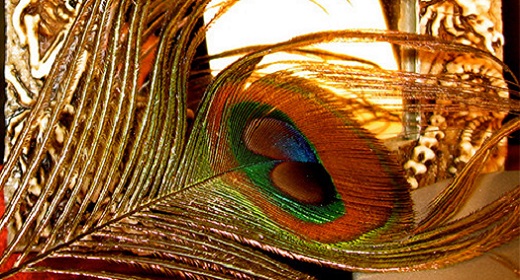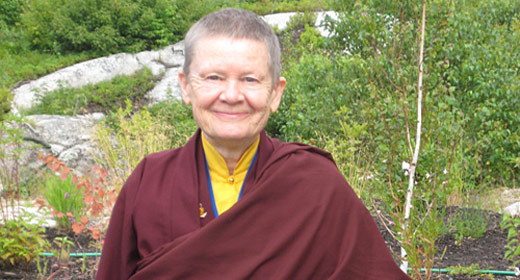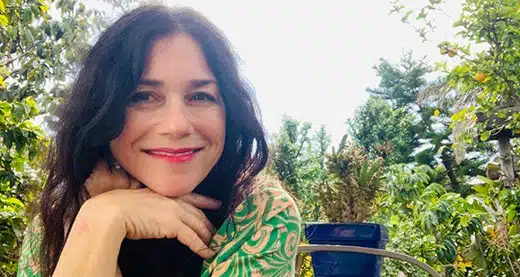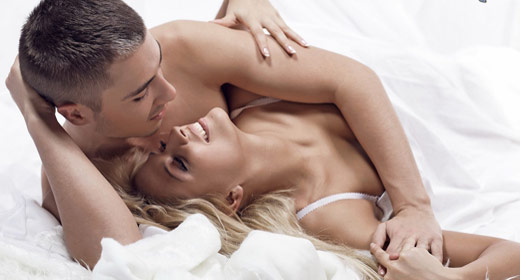by Kino MacGregor: After three days of vacation I sat down and opened my computer to meet nearly 300 emails…

As I sent replies to a few, more came in. I felt buried under a mountain of e-stress. While I don’t work a typical 9-to-5 desk job, I am never not working. If I’m not on the mat, then I’m in front of my computer writing blogs like this one, answering emails, and generally planning how to take over the world. Just kidding—sort of.
Staring at a computer screen for what feels like endless hours is daunting and emotionally draining. It also makes your hips really tight and puts stress on the back. We all know that hunched over, rounded back position that somehow takes over any good intentions to sit up straight. And we all feel it the next day on our mats. It’s as though the more difficult the assignment, the more you have to concentrate and the worse your posture becomes. My secret tip for keeping my hips relatively open and the back supported during long hours of work or travel is to sit cross-legged as often as possible. Switch up the dominant or top leg repeatedly to distribute the weight. Keep the belly drawn in and the chest expanded. From a physiological point of view strengthening your posture helps you breathe deeply and keep an emotionally resilient spirit. If your desk chair is too small to cross your legs in, then get a bigger chair. Or exchange your chair for an exercise ball to build balance and core strength while working.
Posture by itself is no magic solution. Even if you sit in Padmasana with perfect posture all day, there are always distractions. My biggest temptation while working on the computer is to drift away from the task at hand into the infinite world of online shopping. But there is a difference between distracting yourself and truly relieving stress. Next time you find yourself bogged down with emails and to-dos with no motivation to dive in and get the job done, take 10 minutes to disconnect from the computer screen and practice this short yoga sequence to clear your mind, release tension in the hips, and strengthen the back. Return to work refreshed, recharged, and inspired.
Table Top Leg Extension
Start off on your hands and knees. Align the hands shoulder-width apart and the knees hip-width apart. Stabilize the shoulder girdle, engage the pelvic floor, and draw the lower belly in towards the sacrum. Inhale as you root down into your hands and extend the right leg. Straighten the knee, point the toes and reach back as far as possible. Avoid kicking the leg too high and instead focus on maximizing the length through the lower back. Gently extend the spine to emphasize the space between the vertebrae. Hold for 5 breaths. Repeat on the other side.
Table Top Hands and Leg Extension
Start off on your hands and knees. Align the hands shoulder-width apart and the knees hip-width apart. Stabilize the shoulder girdle, engage the pelvic floor and draw the lower belly in towards the sacrum. Inhale as you extend the right leg and the left arm. Do not focus on how high the leg and arm are lifted. Instead maximize the space between the left and the right foot. Gaze forward or, if your balance is challenged, gaze down to your mat just ahead of your right fingertips. Broaden across the upper back, spreading your left shoulder blade, tuck the lower ribs in, draw the sub-navel in, and lengthen the whole body. Stay for 5 breaths. Come down and repeat on the other side.
Puppy Pose I
Utthita Shishosana
Start off on your hands and knees. Align your hands shoulder-width apart and the knees hip-width apart. Slowly walk your hands forward until you feel a light stretch in your shoulders. Tuck your head under. Stack the hips directly over the knees, draw the lower belly in and allow a gentle hip flexion. Drop the forehead toward the ground, resting it there if possible. Actively reach forward with your shoulders and drop the armpits down toward the ground to open the shoulders. Avoid winging out the elbows and actively straighten the arms by drawing the elbows toward each other. Close your eyes. Stay for 5 breaths. Rest in Child’s Pose. Repeat 3 times.
Puppy Pose II
Utthita Shishosana II
If you feel totally comfortable in Utthita Shishosana, then you might be ready to move a little deeper. These two versions Utthita Shishosana give you an easy tool to relieve upper back, neck and shoulder tension that so often accumulates from working on your computer or holding onto stress. However, do not force your body to go too deeply too soon. Only proceed if Utthita Shishosana was relatively comfortable.
If your body is ready, then start off in Utthita Shishosana and lift your chin. Exhale as you slide your chest and sternum down toward the ground. Aim your armpits toward the ground and reach the arms forward. Draw the elbows in towards each other, suck the sub-navel in, and send the hips back and up. Since this is a deeper backbend, it is crucial to support the lower back with the pelvic floor to prevent hyperextension. Remember these poses are aimed to relieve stress, not to do your deepest backbend. Close your eyes. Stay for 5 breaths. Rest in Child’s Pose. Repeat 3 times.
Low Lunge
Anjaneyasana
Long hours sitting in front of a computer are often the culprit behind tight hips. Use this easy version of Anjaneyasana to relieve stress accumulated in the hips.
From Samasthiti, step your right leg back and send the right knee toward the ground. Extend the right leg relatively far back and point the right toes. Stack the left knee over the left foot, being sure the left knee doesn’t go too far ahead of the left toes. Engage the quadriceps and root down toward the inside edge of both legs. Draw the sub-navel in toward the spine and stack the torso in line with the hips. Lift the ribs away from the hips and maximize the space between the vertebrae. Bring your hands to prayer, gazing forward. Stay for 5 breaths.
Next, inhale as you raise your hands overhead. Press the palms together and gaze up towards the thumbs. Stay for 5 breaths, then switch the sides.
Crescent Lunge
If you feel stable in Anjaneyasana, you might be ready for a greater challenge. If not, then simply repeat Anjaneyasana.
Start off in the basic lunge position with the hands in prayer, curl the right toes under and engage the pelvic floor. Ground into the base of the left foot and enervate the right leg. Inhale to send the right leg back, lift the right knee and allow the hips to rise. Expect to feel a rather intense stretch through the front of the right thigh. Stay for 5 breaths.
Your balance will be challenged, so take the time to check in before you proceed. If you feel stable, then inhale as you raise your hands overhead. Press the palms together and gaze up toward the thumbs.
Camel Pose
Ustrasana
Come to a kneeling position. Align the feet and knees hip-width apart. Draw the thighs gently toward each other to facilitate an internal rotation of the hips. Activate the quadriceps and root down through he inner edges of the knees. Inhale as you send the hips forward, lift the ribs away from the hips, and send the sternum up. Exhale as you fold through the vertebrae to arch the spine. Support each of the joints of the spine by activating the back muscles and avoid dumping weight into the lower back. Place the hands on the soles of the feet, aligning the fingers with the toes. Roll the shoulders forward to internally rotate the shoulder joints. While this might seem counterintuitive, this shoulder alignment is crucial to support the cervical spine. Once the shoulders are in place, then drop the head back into the support of the trapezius muscles. Gaze between the eyebrows. Stay for 5 breaths. Inhale come up. Exhale rest in Child’s Pose.









































